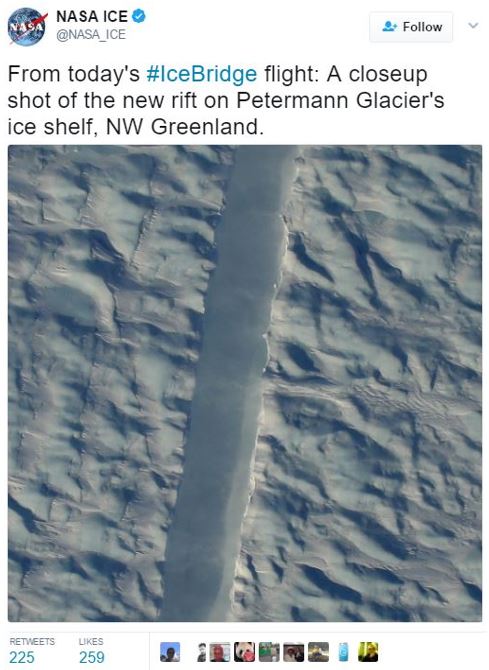A mysterious glacier crack in one of the largest glaciers in Greenland has appeared near the center of the ice shelf, say baffled scientists who were gathering and examining satellite data from the Petermann glacier. NASA field campaign Operation IceBridge captured the first photographs of the crack, which researchers say is growing.
Scientists say they are monitoring the glacier crack closely, because they believe it holds back a foot of potential sea level rise from the region’s ice sheet.
The glacier moves slowly toward the sea, along the Greenland’s northwestern coast, terminating in a large floating ice tongue.
 It is unusual to find a glacier crack near to the center of the ice shelf, i.e. so far away from the sea. If warm water underneath is the cause, how did it get there? (Image: twitter.com/NASA_ICE)
It is unusual to find a glacier crack near to the center of the ice shelf, i.e. so far away from the sea. If warm water underneath is the cause, how did it get there? (Image: twitter.com/NASA_ICE)
Does glacier crack signal imminent break?
The development of the new crack could mean that in a few years’ time there will be a dramatic break, say the researchers after examining the satellite pictures.
The Petermann Glacier is a massive tidewater glacier located in North-West Greenland to the east of the Nares Strait. The glacier consists of a 43-mile (70 km) long and 9.3-mile (15 km) wide floating ice tongue, whose thickness ranges from 98 to 262 feet (30 to 80 meters) at its front to 2,000 feet (600 meters) at its grounding line.
The glacier is one of the most important outlets by which the Greenland ice sheet extends and flows into the ocean. In 2010 it lost a very large piece, several times the size of Manhattan island from its ice shelf – in 2012, it lost another similar-sized one.
 Terminus of Kangerlugssuup Sermerssua glacier in West Greenland. NASA says that scientists have identified which glaciers in West Greenland are more susceptible to melting (thinning) in the decades to come – it is all down to their shape. NASA wrote: “The research could help predict how much the Greenland Ice Sheet will contribute to future sea level rise in the next century, a number that currently ranges from inches to feet.” (Image: nasa.gov. Credit: Timothy Bartholomaus, Univ. of Idaho)
Terminus of Kangerlugssuup Sermerssua glacier in West Greenland. NASA says that scientists have identified which glaciers in West Greenland are more susceptible to melting (thinning) in the decades to come – it is all down to their shape. NASA wrote: “The research could help predict how much the Greenland Ice Sheet will contribute to future sea level rise in the next century, a number that currently ranges from inches to feet.” (Image: nasa.gov. Credit: Timothy Bartholomaus, Univ. of Idaho)
In an interview with Mail Online, Stef Lhermitte, a researcher at Delft University of Technology in the Netherlands, said regarding the new crack that is appearing in the middle of the ice shelf:
“As far as I understand, the island might not break off until later this summer or even next summer. As this part of the ice shelf is already floating the break-off of the island will not affect sea level rise [i.e. floating ice and water have exactly the same volume].”
“But understanding the glacier response on the longer term is important as it holds back a large amount of ice from the Greenland ice sheet.”
Why is this crack of concern?
This new crack is of particular concern to scientists because of where it is. The majority of glacier cracks appear relatively near to the sea as the warmer waters and angle of descent cause ice to break off and float into the ocean.
This new crack, however, is very close to the middle of the ice shelf, quite a long way from the sea, which suggests that another factor is at play.
Lhermitte suggests that the crack probably formed due to warmer water flowing below the glacier. Nobody quite knows how this warmer water got there.
If the glacier cracks and a large chunk – say bigger than Manhattan Island – floats away, the level of the sea would not be affected, given that the ice is already floating. However, it would make room for new ice to start making its way into the sea, which would then contribute to a small rise in the sea level.
Video – Glacier crack in Greenland
This Newsy video talks about the glacier crack that has appeared in the center of an ice shelf, which is strange – most of them appear near the sea.
